#knifefish?
Explore tagged Tumblr posts
Text
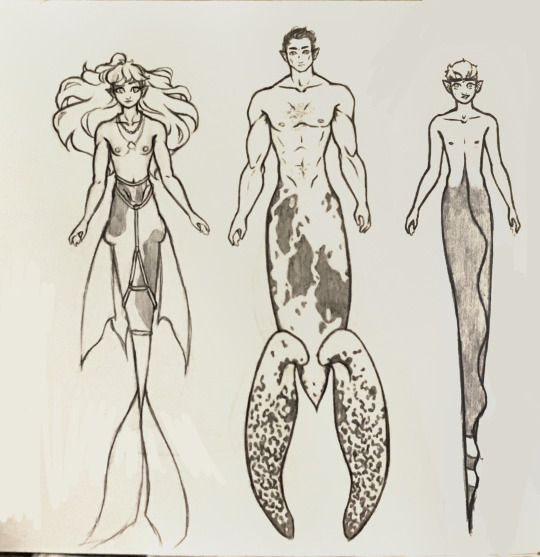
Babs, Bruce and Danny in my dpxdc merfolk au!!!
argh, plz excuse the poorly edited photo lmao- lost a lot of detail TvT
Babs has her info Here. But this is her design! I’m not actually entirely sure if any of these designs are final, i might tweak them, but here she is! I gave her necklaces.
Bruce is based on a leatherback sea turtle! The spots aren’t actually super accurate to a leatherback’s underside, but if you look at it a little harder... you may find a fun little easter egg. It’s subtle... or at least i tried to make it that way. (If people don’t get it i’ll explain in a rb lol) Did you know that leatherback sea turtles can be up to 880 pounds? Idk what that is in metric but that’s roughly 7 and a half Bahfevs. They’re also much more triangular/less round than other turtles, so I reflected that in his design. And ofc, Bruce and Damian are both sea turtles bc they’re related. But they’re different sea turtle species so it doesn’t make much sense. Who gives a flip. What’s Talia, you ask? To that I say: 🤷♀️
(Side note: apparently, I’ve conditioned myself so I can’t draw nuetral expressions. It’s gotta have some emotion or else it looks wrong, and it feels natural to always have something going on there. So... drawing Stoic McStoicface here was a pain in the penis. He kinda has an expression anyway lol)
Danny is based on a ghost knife fish! I’ll be honest, i didn’t even know these existed until I looked up “ghost fish” in the hopes of finding something thematic. But then... omg! They’re black with little white accents? Like Danny’s design? And they have cool, funky bodies? AND they produce electricity!?? That’s so FKING COOL! I’ll have to do more research, but so far i’m pretty sure they don’t produce enough electricity to hurt someone. They are related to electric eels though! I first learned that electric eels were knife fish and not true eels when I was researching the moray eel for Duke. Funny how that connects!
Danny’s story under the cut!
Heehoo!
Okay so basically: Danny went diving to gather pearls because he wanted to make his parents happy/proud. While he was diving, His foot got caught in a rock and he couldn’t get it out. He panicked and he begged— to who? God, maybe? The universe, or the ocean? Maybe just begging fate or any higher power that could be out there, he doesn’t know. His only prayer was “Don’t let me drown!”. Unbeknownst to him, one of the pearls he’d grabbed was a magic, wish granting pearl. They’re rare enough that humans don’t even have legends of them... but the merfolk do ;).
The pearl took his very non-specific wish and decided to give him a tail and gills. He swam back up in a panic, and saw his new tail. Of course, this is a very horrifying thing to happen. But in less than a minute... it was already starting to dry off. As it dried, it turned back into skin.
Now, Danny has to be extremely careful not to get his legs or hair wet when he’s near people, because he’ll turn back into a merboy.
i... probably should have given him a shirt? He’d be wearing it, right? But i also did need to see what I was doing with that fin thing lol. I mean, a shirt would get annoying with that fin- he’d probably take it off. Tbh he’d probably have it off when swimming in general? Idk.
So: funny thing that happened when I was drawing Danny:
A first grader came up to me while I had it open on my desk, and she was like:
“Oh my god, that’s so good! Like, how did you even draw that?”
so I was like: “Oh thank you! ❤️”
And I think she asked again “How did you even draw that?”
so I was a little confused on how to answer, so I said:
“Well, I used my pencil...” and held up my pencil—
and then she got distracted by a spinny chair.
She’s so precious omg 🥰
#barbara gordon#danny fenton#danny phantom#dpxdc#bruce wayne#literally forgot his name there for a sec#art#my art#btw i have all the posts for this au tagged under#dpxdc merfolk au#so once you’ve scrolled through it you don’t need to go hunting for any that maybe didn’t get tagged#they’re all there#Leatherback sea turtle#leatherback turtle#ghost knife fish#knifefish?#is it one word or two??#merfolk au#merfolk#merpeople#mermaid#merman
51 notes
·
View notes
Note
TRICK OR TREAT!! (I love your blog btw!)
Why thank you kumquat! Here's a creepy friend for you!

Black Ghost Knifefish (Apteronotus albifrons), family Apteronotidae, found in freshwater habitats in much of South America
This nocturnal fish produces a weak electrical field that helps it locate prey and find its way around in the dark.
photograph by J. Richter
235 notes
·
View notes
Text
Fish fact #590
Fish anatomy!

The anal fin is a fin that's located on the underside of the body behind the anus, many fishes have this fin. Its main purpose is to stabilise the fish while it's swimming, but some fishes like the knifefishes use it exclusively for propulsion! Pufferfishes, sunfishes and boxfishes use the anal fin in tandem with the dorsal fin to swim.
#the fish in the picture is a ghost knifefish!#fish#fishfact#fish facts#fishblr#marine biology#biology#zoology#fish anatomy#fish fins
568 notes
·
View notes
Note
What fish fits me
Slightly unsettling but very loveable

You get a Black Ghost Knifefish
Apteronotus albifrons
96 notes
·
View notes
Text


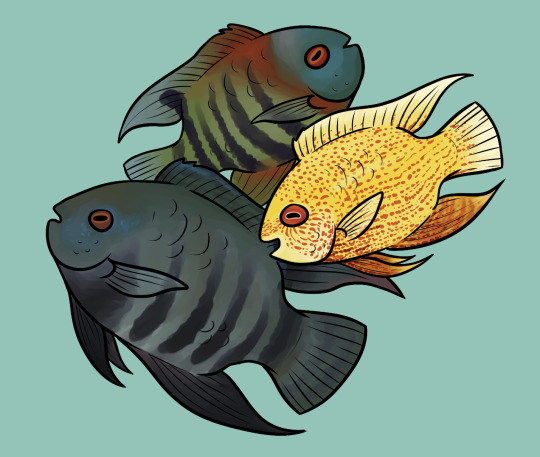



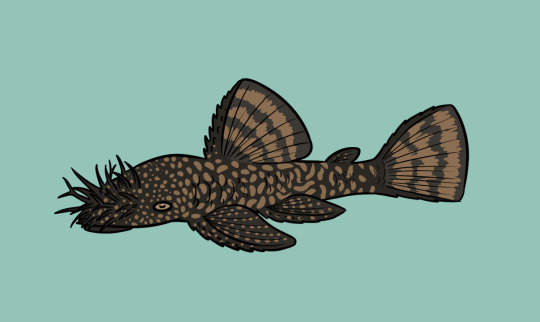
Fish time
#all the fish were made into stickers#the tank was based off my 2ft which has now been converted into a bug tank#fish#bristlenose catfish#ghost knifefish#severums#festivum#frontosa#marbled headstander#evanesce art#these were all done a couple of years ago
327 notes
·
View notes
Text
Wet Beast Wednesday: electric eel
Prepare to be jolted this Wet Beast Wednesday as we dive into the shocking world of electric eels. The fist thing to know about electric eels is that the name is a lie. Not the electric part, that's true, but the eel part. Despite appearances, electric eels are actually knifefish, a group of freshwater fish that are more closely related to catfish and piranha than to true eels.

(Image: three electric eels swimming in an aquarium. One in front is seen in profile. It is an elongates, slender, brown fish with tiny pectoral fins and a long anal fin that runs under most of the body. End ID)
There are three species of electric eel, though they are so similar to each other that they were previously classified as one species. The species are Electrophorus electricus, Electrophorus voltai, and Electrophorus varii. The main difference between the species are in the shape of the skull. All electric eels are elongated fish that are cylindrical at the front and flattened vertically at the tail. They have no pelvic or dorsal fins and the tail fin is small and fused with the anal fin, which runs across most of the body. The anal fin is the primary means of locomotion for the eels. By undulating the fin in a wavelike motion, the eel can swim forward, backward, or hover in place. The body of the eel is scaleless, instead bing covered in muddy brown skin. Electric eels grow throughout their entire lives and grow new vertebrae as they get longer. The largest species, E. electricus, can reach 2 meters (6.6 ft) long and weighs up to 20 kg (44 lbs). They are obligate air-breathers, being incapable of obtaining enough oxygen through their gills to survive. Instead, they must surface every two to ten minutes to breathe. The inside of the mouth is wrinkly and heavily vascularized, resulting in a high surface area that can absorb oxygen as long is it stay wet. The floor of the mouth can flex to draw air in and then it is forced out through the gills. Carbon dioxide is excreted through the skin. Electric eels have poor eyesight, but have electroreception and very good hearing thanks to Webers apparatus, a set of tiny bones that connect the inner ear to the swim bladder. The apparatus amplifies sounds that the ear would not be able to detect on its own.

(Image: a close-up of an electric eel's head. It is round and brown, reminiscent of a potato in texture. The mouth is located on the frond and is closes, with no visible teeth. Tje eye is very small and pale blue. Across the head are sensory pits that look like small holes. End ID)
All of the vital organs of the eels are packed into the first fifth of its body length. The rest of the body contains the electric organs. Keeping the vital organs in the front of the body isolates them from the electric organs, preventing the fish from damaging their organs while generating electricity. The electric organs take up so much more space because they need to generate very powerful electric shocks. Most fish that hunt with electricity are saltwater species as salt water conducts electricity much better than freshwater. Because electric eels are freshwater fish, they need to generate much more powerful shocks to effectively hunt other animals. E. voltai can produce a maximum recorded 860 volts of electricity, the highest of any animal. Electric eels are electroreceptive, able to sense electric fields in their surroundings. Electroreception is divided into passive (animal senses electric fields of others) and active (animal generates its own electric field and can sense distortion in that field caused by other objects or animals). Electric eels are active electroreceptors. They sense changes in their electric field using sensory pits on the head that are derived from the lateral line system that all fish have. Electric eels have three electric organs: the main organ, Sach's organ, and Hunter's organ. The main organ sits in from of the Sach's organs while the Hunter's organ sits beneath both. The organs are derived from muscles and consist of stacks of structures call electrocytes, which are made up of specialized cells. When the brain sends a signal to the electric organs to produce a shock, special ion channels pump sodium ions into the cells while different channels pump potassium out. This creates a sudden difference in electric potential, which is what generates the shock. Producing electricity is a costly process and the eels need rest and nourishment between multiple successive shocks. The main organ generates the powerful shocks used to stun prey while the Sach's organ creates weaker shocks used for active electroreception. Hunter's organ appears to support the other two.
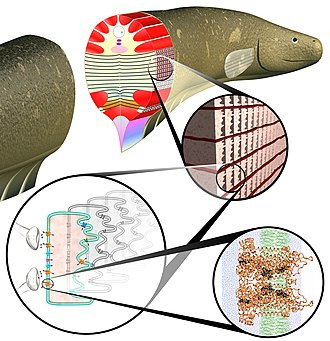
(Image: an artistic depiction of a cross-section of an electric eels, showing the structure of the main electric organ. From there, the image is zoomed in on multiple times, showing the the structure of the electrophytes, the protein channels, and the structure of the proteins involved in generating electricity. End ID. Art by Daniel Zukowski)
Electric eels are found in northern South America and the ranges of the three species generally do not overlap. They prefer muddy bottoms or swampy areas. The terrain of their territory changes quite a bit through the year. In the wet season, water levels rise, flooding sections of forest and grassland and connecting streams and ponds. In the dry season, water levels drop and many streams and ponds are isolated. These isolated bodies of water become warm, low-oxygen areas where fish that rely on gills are at a disadvantage while air-breathing fish like the electric eels can thrive. Electric eels are nocturnal predators that detect and stun prey through their electric abilities. Their diet consists mostly of fish, but they will take just abut anything. While mostly solitary, E. varaii have been observed coordinating with each other to hunt schools of tetras. When the electric field generated by Sach's organ is disturbed by another animal, the eel will use the main organ to produce a strong shock to stun the prey. Stunning can be done from a distance, but is more effective if the eel makes contact with the other animal. An initial shock may be used to temporarily immobilize prey long enough for the eel to contact it and release a second shock. Some sources propose that the eel can use its shock to forcibly contract muscles in other animals, either immobilizing prey or forcing prey to move, making them easier to sense. Where or not this is something the eels can actually do is up for debate. Electric eels also use their shocks to deter potential predators. When feeling threatened by something on land, the eel can leap out of the water to make contact with the threat and shock it. Very few animals prey on electric eels, but known predators include caiman, alligators, and piranha.

(Image: six frames showing na electric eel in captivity responding to a perceived threat (a fake caiman head) by partially leaping out of the water and contacting the head to shock it, before returning to the water. End ID)
Electric eels breed in the dry season. Males will use their saliva to glue together mud and sand into nests where the females lay their eggs. The male then fertilizes the eggs by releasing sperm onto them. The females may lay eggs multiple times during the breeding season and can lay up to 1200 at a time. The male stays by the nest to guard the eggs and hatchlings for up to four months. The lifespan of electric eels is in question, but captive specimens can live for up to 20 years.
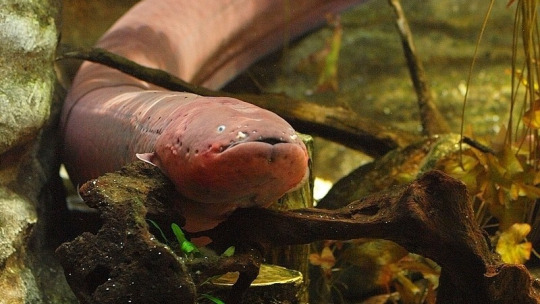
(Image: an electric eel resting on a pile of wood next to some rocks. End ID)
All species of electric eel are classified as least concern by the IUCN, meaning they are not at threat of extinction. Threats to them mostly consist of pollution and habitat loss. Studies of the electric properties of the eels have lead to multiple discoveries and inventions. In particular, Luigi Galvani was inspired by studies on the eels when he invented the battery. Electric eels are also important in the study of the voltage-gated sodium channel. These channels are used to generate electricity, but are also used to trigger the contraction of muscle cells in many species, including humans. It is hard to study the channels in muscle cells because they are found in very small amounts. The electric organs of the electric eel have much higher quantities of these channels, making it much easier to study them. Better understanding of voltage-gated sodium channels could lead to improvements in prostheses and medical implants.

(Image: a cartoon showing an electric eel swimming with a black cloud emerging from its tail. Threee other eels watch from the side, one commenting "Ew... I can't believe he's still running on fossil fuels". End ID. Source)
#wet beast wednesday#electric eel#fish#fishblr#knifefish#freshwater fish#biology#zoology#ecology#animal facts#informative#science
106 notes
·
View notes
Text


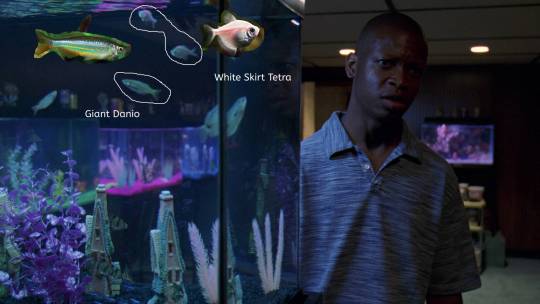
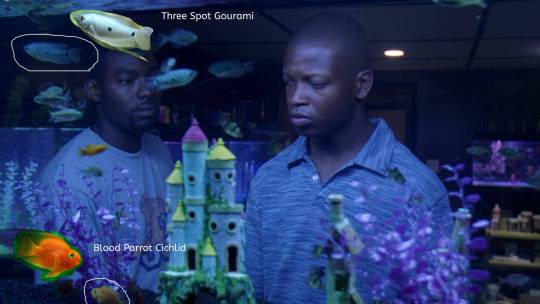

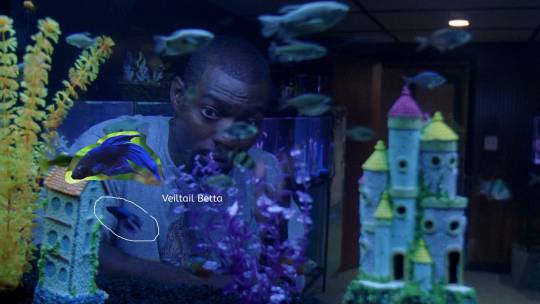

"These are my tetras." WeeBey says, pointing to a tank full of gouramis, platies or mollies, giant danios, tiger barbs, a betta, and what looks like a very small blood parrot cichlid. There's what could be some white & black skirt tetras in there too I guess, also I think I saw a painted glassfish swim by. This tank is something
those very sad goldfish/maybe koi in that other little tank, nooo
and i'm pretty sure thats a knifefish you can see in one of the background tanks too
All that money and his tanks are so ugly :( It's time someone draggeed WeeBey's fish room
#The Wire#fishblr#feesh#it is funny that his centerpiece tank is full of pretty common lil guys#but there's a knifefish off in the corner#this post is just for me don't take it too serious
121 notes
·
View notes
Note
just learned about the electric eel's cooler (not) cousin, the African Knifefish (Gymnarchus niloticus). would be cool to see on in your style! c:

fish 188 - african knifefish/g. niloticus
169 notes
·
View notes
Text
Taxonomy Tournament: Fish
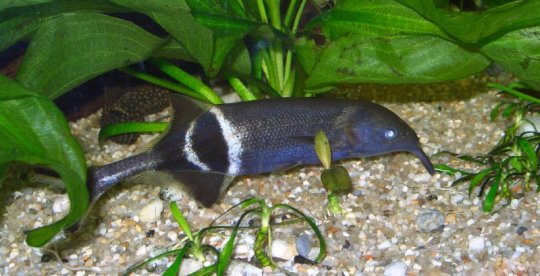

Osteoglossiformes. This order is made up of relatively primitive fish, which have bony tongues. Members include elephantfish and African knifefish.
Hiodontiformes. This order is made up of mooneyes, so called due to the shine of their large eyes
#animals#biology#polls#poll tournament#zoology#african knifefish#fish#mooneyes#Osteoglossiformes#Hiodontiformes#0x44v0xbb#animal tournament#Animal Tournament Round 1
57 notes
·
View notes
Text
for day 16 (freshwater fish) i present: an electric eel :D
they may not look very fishy but theyre actually a type of fish called knifefish rsther than a true eel :]
@fish-daily

35 notes
·
View notes
Text

cTubbo electric eel ⚡️
@transbeeduo ever since you mentioned it I could not get it out of my head. Electric eel fits him perfectly
He uses his electric current to work on stuff in the lab 👍
#fun fact: electric eels are not actually eels#they are a type of knifefish#this was a warmup but I still like it so I’m posting it in the finished art tag#art#ctubbo#c!tubbo
42 notes
·
View notes
Text

Mermaid & monkey pools
#mermay#mermay 2024#mermaid#waterfall#forest#monkey#pig tailed macaque#clown knifefish#kingfisher#sunbird#dragonfly#butterfly#beetle#frog#magpie#pigeon
9 notes
·
View notes
Text

Black Ghost Knifefish (Apteronotus albifrons), family Apteronotidae, found in freshwater habitats in much of South America
This nocturnal fish produces a weak electrical field that helps it locate prey and find its way around in the dark.
photograph by J. Richter
283 notes
·
View notes
Text
Daily fish fact #862
Banded knifefish!

Like other knifefishes, it moves mainly via undulating its anal fin and can effortlessly move forwards and backwards thanks to this! Weak electric discharge capabilities allows this fish to navigate their environment and find prey.
#seemed appropriate for the occasion#fish#fishfact#fish facts#biology#zoology#knifefish#banded knifefish#fishblr
48 notes
·
View notes
Note
Kindly provide the silliest freshwater fish you can. :)
Without a doubt, has gotta be This Thing™️

You get a Clown Knifefish
Chitala ornata
46 notes
·
View notes
Text

They really look much better when you can see them move, generally.
#mermay#mermaid#mermay 2024#art challenge#this is a fish i actually did a few years ago but I don't think I did it very well then#so this is a bit of a redemption#she's a black ghost knifefish!#they're pretty :3 and have such cute faces
10 notes
·
View notes